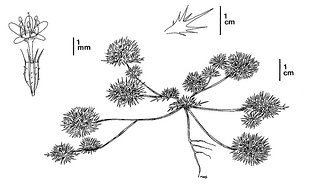(Navarretia leucocephala ssp. plieantha)
 Navarretia leucocephala ssp. plieantha. Photo © Aaron Arthur.
Navarretia leucocephala ssp. plieantha. Photo © Aaron Arthur.
 Navarretia leucocephala ssp. plieantha. CDFW illustration by Mary Ann Showers. (Click to enlarge)
Navarretia leucocephala ssp. plieantha. CDFW illustration by Mary Ann Showers. (Click to enlarge)
Many-flowered navarretia is a California endangered plant species, which means that killing or possessing the plant is prohibited by the California Endangered Species Act (CESA). Many-flowered navarretia is also listed as endangered under the federal Endangered Species Act. Many-flowered navarretia is a small annual herb that forms in mats and produces 10-60 small pale blue flower heads that typically bloom from April to June. Flower numbers are usually twice that of the closely related subspecies few-flowered navarretia (Navarretia leucocephalassp. pauciflora). Many-flowered navarretia is a vernal pool plant, and is found only in these unique wetlands. It is included in the Recovery Plan for Vernal Pool Ecosystems of California and Southern Oregon (PDF) (Recovery Plan) completed by the U.S. Fish and Wildlife Service in 2005.
At the time of this webpage posting, the California Natural Diversity Database lists eight occurrences of many-flowered navarretia that are presumed to still exist; however the survey data for these occurrences has not been recently updated. Two of these occurrences, Boggs Lake Ecological Reserve and ;Loch Lomond Vernal Pool Ecological Reserve, are on property owned by CDFW, and Boggs Lake is also managed by The Nature Conservancy. The remaining six occurrences are on privately-owned land.
Like other vernal pool species, the biggest threat to many-flowered navarretia is habitat loss and fragmentation due to agriculture and development. Development can result in direct removal of vernal pool habitat as well as indirect consequences such as altered hydrology, runoff, invasive species encroachment, and groundwater contamination. Climate change is also a threat to vernal pool species. Threats specific to many-flowered navarretia include rooting by feral pigs, horseback riding, and impacts from recreational activity. The occurrence at Boggs Lake faces threat from invasion by thistle (Cirsium spp.), knapweed (Centaurea spp.), and cattail (Typha spp.), while the occurrence at Loch Lomond may face threats from off-highway vehicle use and road maintenance activities near the preserve. Threats to the privately owned occurrences include development, grazing, and invasive species.
Occurrences of many-flowered navarretia on privately-owned land should be protected through conservation easements or other means. A Draft Management Plan for the Loch Lomond Vernal Pool Ecological Reserve (PDF) has been prepared and should be implemented, and management plans should be written and implemented for the other occurrences on publicly-owned land. Surveys should be conducted at all occurrences to determine the current status of the species. Additionally, research should be conducted on the genetic structure and taxonomic status of many-flowered navarretia and its related subspecies. Potential habitat should be surveyed, and if new populations are located, they should be protected. Recommended actions to help vernal pool species in general can also be found in the Recovery Plan.
CDFW may issue permits for many-flowered navarretia pursuant to CESA, and you can learn more about the California laws protecting many-flowered navarretia and other California native plants. Populations of many-flowered navarretia occur in CDFW’s North Central and Bay Delta Regions. More information is also available from the U.S. Fish and Wildlife Service Species Profile for Many-Flowered Navarretia.
Updated 01/14/2014